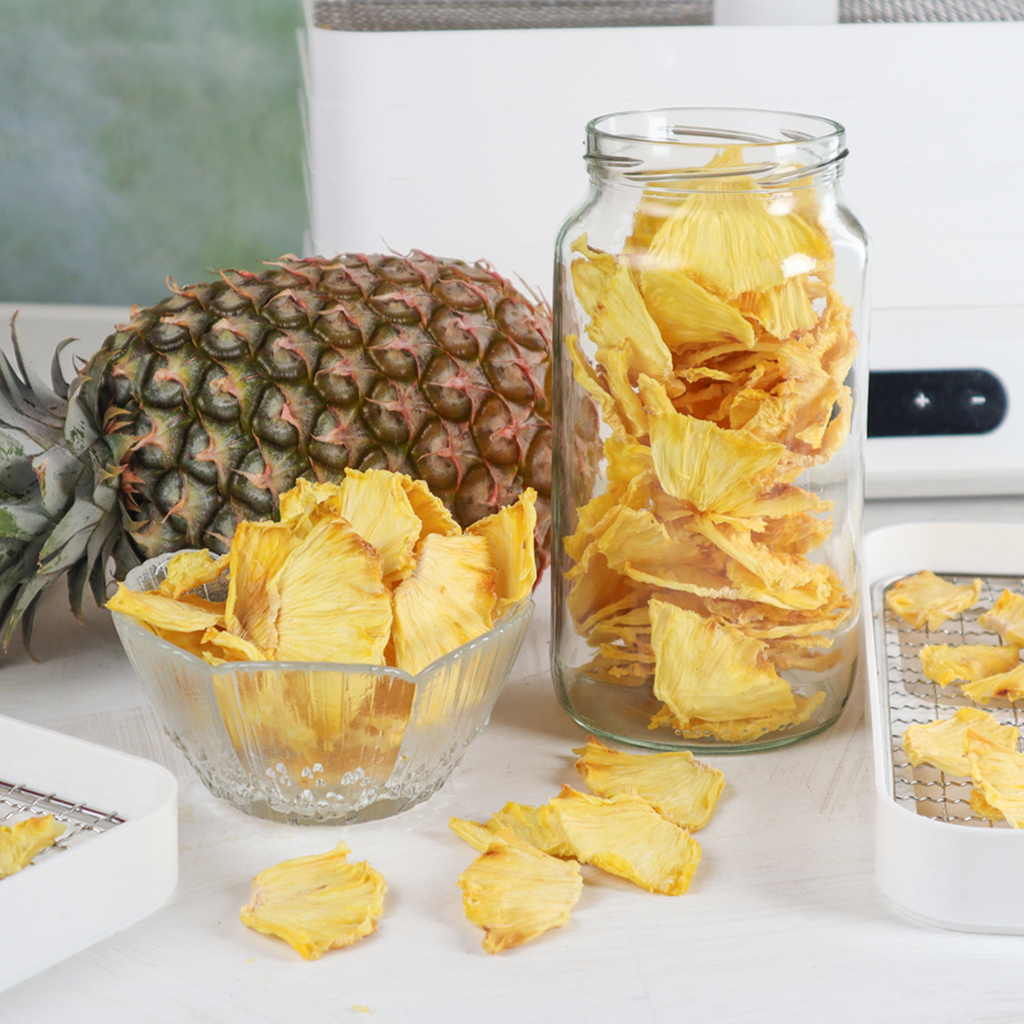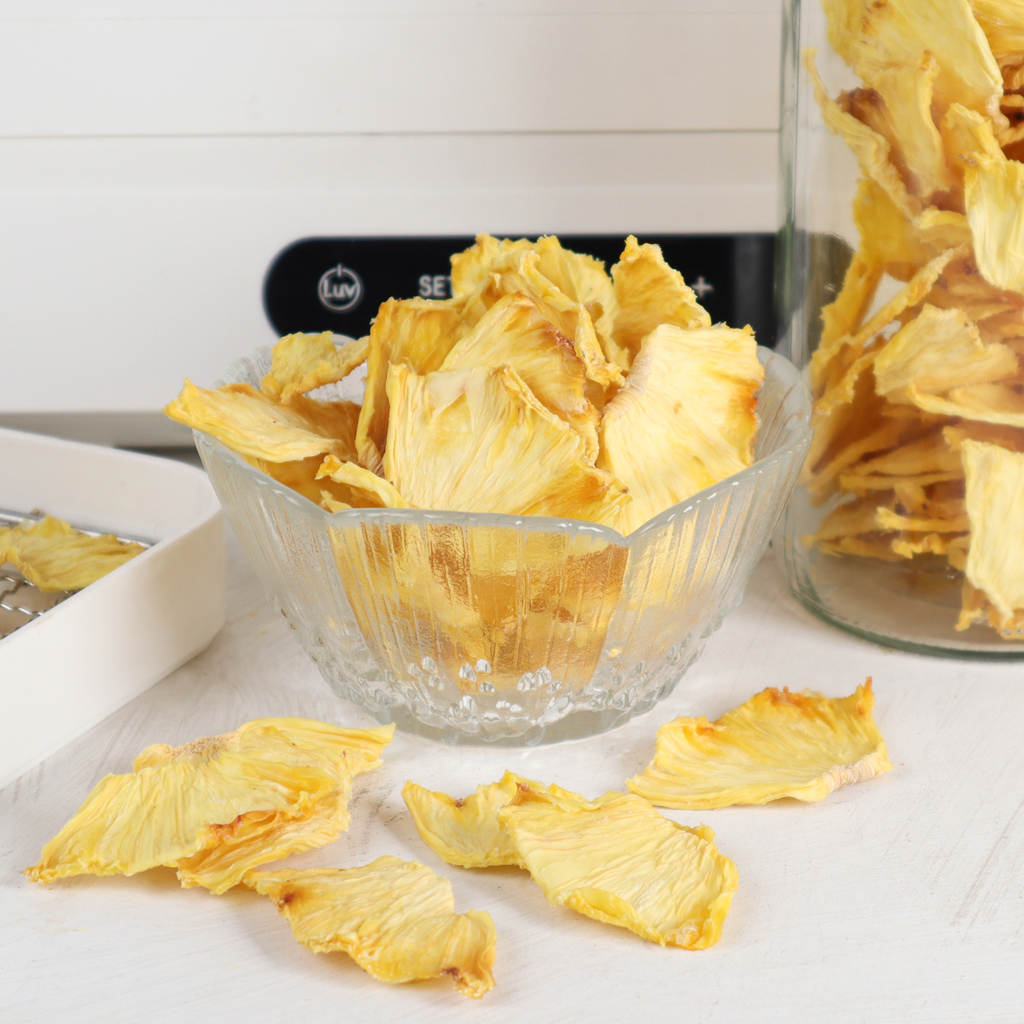Your Cart is Empty

Drying fresh pineapple in a dehydrator is easy
Barb Hodgens
Barb Hodgens loves to cook with alternative, healthy whole food ingredients, with a focus on gut health. Barb has overcome her own gut health issues through healthy eating. Share your ideas, comments and photos at the end of this post :)

A sweet grab-and-go healthy snack.
Dehydrating pineapple is really simple. Fresh pineapple doesn’t need any pre-treatment so it’s perfect for Breeze dehydrator newbies, or just busy mums who want healthy snacks on continuous rotation.
Homemade dehydrated pineapple is unlike the dried pineapple you find in the store. It’s so much better! It’s got to be one of the sweetest snacks around and bursting with natural tropical colour. The riper the fruit the more sweet and amazing the flavour will be. There’s absolutely no reason for added sugar or preservatives when you dry pineapple yourself.

Cut it super thin and get yourself some pineapple chips or slice it thicker for delectable chewy goodness.
The final product retains all of the fibre and vitamins yet takes up a fraction of the space and can be stored for months, even years!

WATCH HOW IT'S DONE HERE
INGREDIENTS
Fresh pineapple (2 large pineapples fill 6 Breeze dehydrator trays)
METHOD
1. Choose fresh pineapples that have a sweet ripe smell.
2. Slice off the top and bottom, then cut away all of the sides, taking off as much of the spines as possible. Also, cut out any bad spots.
3. Discard all the waste and clean your cutting board.
4. At this point you can choose to cut the pineapple into rings or chunks. We chose chunks because it’s the easiest. Depending on your knife skills you can slice by hand or use a mandolin.

5. For rings – lay the pineapple on its side then slice into even 5-6 mm rings. Use a small sharp paring knife to remove the hard centre out of each segment.
6. For chunks – set the pineapple on its end. With a large knife, slice in half lengthways and then into quarters. Cut off the hard centre then slice into 4-5mm segments using a knife or mandolin. (For crispier pineapple chips slice into 3mm segments)
7. Place your sliced pineapple onto your dehydrating trays. You can arrange the pieces quite close together but don’t overlap.

8. Set the dehydrator to 70°C / 160°F and the time to 10 hours. Check in on the pineapple every few hours after that until it is pliable, but not overly crisp. Dehydrating times will vary depending on the variety of pineapple you are using. Some pineapples are firm while others are very juicy. The thickness of the slices and the ripeness of the fruit will also effect the drying time.
If you are planning to use your dehydrated pineapple for long-term storage it is best to dehydrate it for longer. If your pineapple is too moist it will begin turning brown and grow mould.
If you are dehydrating pineapple for eating right away and you aren’t intending on preserving it for long-term storage, then undercook it slightly so that it is still very pliable and chewy.
For long-term storage, we recommend vacuum sealing.
You might also like to dehydrate mango.

PIN THIS RECIPE

Drying fresh pineapple in a dehydrator is easy

A sweet grab-and-go healthy snack.
Dehydrating pineapple is really simple. Fresh pineapple doesn’t need any pre-treatment so it’s perfect for Breeze dehydrator newbies, or just busy mums who want healthy snacks on continuous rotation.
Homemade dehydrated pineapple is unlike the dried pineapple you find in the store. It’s so much better! It’s got to be one of the sweetest snacks around and bursting with natural tropical colour. The riper the fruit the more sweet and amazing the flavour will be. There’s absolutely no reason for added sugar or preservatives when you dry pineapple yourself.

Cut it super thin and get yourself some pineapple chips or slice it thicker for delectable chewy goodness.
The final product retains all of the fibre and vitamins yet takes up a fraction of the space and can be stored for months, even years!

WATCH HOW IT'S DONE HERE
INGREDIENTS
Fresh pineapple (2 large pineapples fill 6 Breeze dehydrator trays)
METHOD
1. Choose fresh pineapples that have a sweet ripe smell.
2. Slice off the top and bottom, then cut away all of the sides, taking off as much of the spines as possible. Also, cut out any bad spots.
3. Discard all the waste and clean your cutting board.
4. At this point you can choose to cut the pineapple into rings or chunks. We chose chunks because it’s the easiest. Depending on your knife skills you can slice by hand or use a mandolin.

5. For rings – lay the pineapple on its side then slice into even 5-6 mm rings. Use a small sharp paring knife to remove the hard centre out of each segment.
6. For chunks – set the pineapple on its end. With a large knife, slice in half lengthways and then into quarters. Cut off the hard centre then slice into 4-5mm segments using a knife or mandolin. (For crispier pineapple chips slice into 3mm segments)
7. Place your sliced pineapple onto your dehydrating trays. You can arrange the pieces quite close together but don’t overlap.

8. Set the dehydrator to 70°C / 160°F and the time to 10 hours. Check in on the pineapple every few hours after that until it is pliable, but not overly crisp. Dehydrating times will vary depending on the variety of pineapple you are using. Some pineapples are firm while others are very juicy. The thickness of the slices and the ripeness of the fruit will also effect the drying time.
If you are planning to use your dehydrated pineapple for long-term storage it is best to dehydrate it for longer. If your pineapple is too moist it will begin turning brown and grow mould.
If you are dehydrating pineapple for eating right away and you aren’t intending on preserving it for long-term storage, then undercook it slightly so that it is still very pliable and chewy.
For long-term storage, we recommend vacuum sealing.
You might also like to dehydrate mango.

PIN THIS RECIPE

Subscribe
Sign up to get the latest on sales, new releases and more …
Item is added to cart
